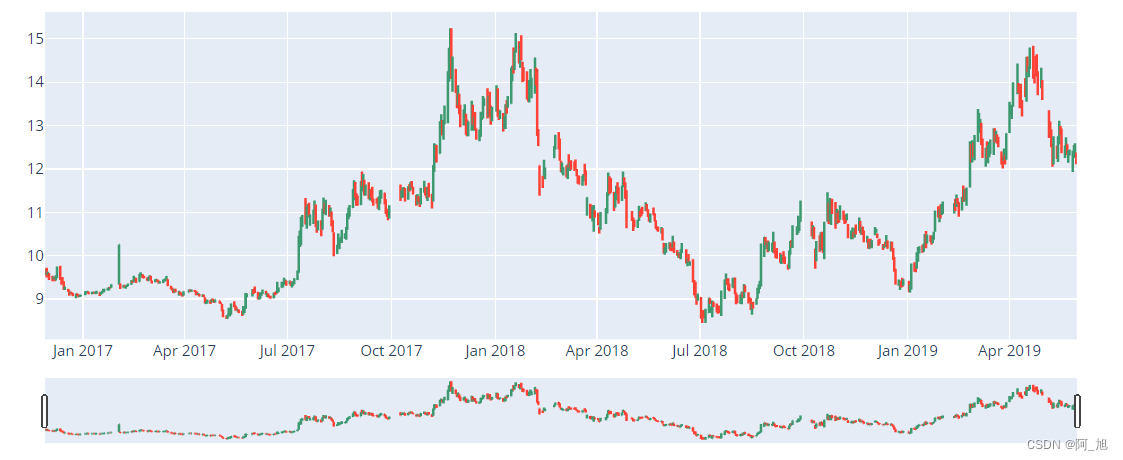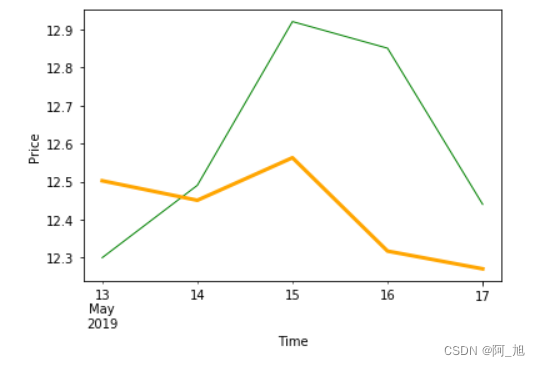【阿旭机器学习实战】系列文章主要介绍机器学习的各种算法模型及其实战案例,欢迎点赞,关注共同学习交流。
注:本文模型结果不好,仅做学习参考使用,提供思路。了解数据处理思路,训练模型和预测数值的过程。
1. 读取数据
import numpy as np # 数学计算
import pandas as pd # 数据处理
import matplotlib.pyplot as plt
from datetime import datetime as dt
关注公众号:阿旭算法与机器学习,回复:“ML31”即可获取本文数据集、源码与项目文档,欢迎共同学习交流
df = pd.read_csv('./000001.csv')
print(np.shape(df))
df.head()
(611, 14)
| date | open | high | close | low | volume | price_change | p_change | ma5 | ma10 | ma20 | v_ma5 | v_ma10 | v_ma20 | |
|---|---|---|---|---|---|---|---|---|---|---|---|---|---|---|
| 0 | 2019-05-30 | 12.32 | 12.38 | 12.22 | 12.11 | 646284.62 | -0.18 | -1.45 | 12.366 | 12.390 | 12.579 | 747470.29 | 739308.42 | 953969.39 |
| 1 | 2019-05-29 | 12.36 | 12.59 | 12.40 | 12.26 | 666411.50 | -0.09 | -0.72 | 12.380 | 12.453 | 12.673 | 751584.45 | 738170.10 | 973189.95 |
| 2 | 2019-05-28 | 12.31 | 12.55 | 12.49 | 12.26 | 880703.12 | 0.12 | 0.97 | 12.380 | 12.505 | 12.742 | 719548.29 | 781927.80 | 990340.43 |
| 3 | 2019-05-27 | 12.21 | 12.42 | 12.37 | 11.93 | 1048426.00 | 0.02 | 0.16 | 12.394 | 12.505 | 12.824 | 689649.77 | 812117.30 | 1001879.10 |
| 4 | 2019-05-24 | 12.35 | 12.45 | 12.35 | 12.31 | 495526.19 | 0.06 | 0.49 | 12.396 | 12.498 | 12.928 | 637251.61 | 781466.47 | 1046943.98 |
股票数据的特征
- date:日期
- open:开盘价
- high:最高价
- close:收盘价
- low:最低价
- volume:成交量
- price_change:价格变动
- p_change:涨跌幅
- ma5:5日均价
- ma10:10日均价
- ma20:20日均价
- v_ma5:5日均量
- v_ma10:10日均量
- v_ma20:20日均量
# 将每一个数据的键值的类型从字符串转为日期
df['date'] = pd.to_datetime(df['date'])
# 将日期变为索引
df = df.set_index('date')
# 按照时间升序排列
df.sort_values(by=['date'], inplace=True, ascending=True)
df.tail()
| open | high | close | low | volume | price_change | p_change | ma5 | ma10 | ma20 | v_ma5 | v_ma10 | v_ma20 | |
|---|---|---|---|---|---|---|---|---|---|---|---|---|---|
| date | |||||||||||||
| 2019-05-24 | 12.35 | 12.45 | 12.35 | 12.31 | 495526.19 | 0.06 | 0.49 | 12.396 | 12.498 | 12.928 | 637251.61 | 781466.47 | 1046943.98 |
| 2019-05-27 | 12.21 | 12.42 | 12.37 | 11.93 | 1048426.00 | 0.02 | 0.16 | 12.394 | 12.505 | 12.824 | 689649.77 | 812117.30 | 1001879.10 |
| 2019-05-28 | 12.31 | 12.55 | 12.49 | 12.26 | 880703.12 | 0.12 | 0.97 | 12.380 | 12.505 | 12.742 | 719548.29 | 781927.80 | 990340.43 |
| 2019-05-29 | 12.36 | 12.59 | 12.40 | 12.26 | 666411.50 | -0.09 | -0.72 | 12.380 | 12.453 | 12.673 | 751584.45 | 738170.10 | 973189.95 |
| 2019-05-30 | 12.32 | 12.38 | 12.22 | 12.11 | 646284.62 | -0.18 | -1.45 | 12.366 | 12.390 | 12.579 | 747470.29 | 739308.42 | 953969.39 |
# 检测是否有缺失数据 NaNs
df.dropna(axis=0 , inplace=True)
df.isna().sum()
open 0
high 0
close 0
low 0
volume 0
price_change 0
p_change 0
ma5 0
ma10 0
ma20 0
v_ma5 0
v_ma10 0
v_ma20 0
dtype: int64
K线图绘制
Min_date = df.index.min()
Max_date = df.index.max()
print ("First date is",Min_date)
print ("Last date is",Max_date)
print (Max_date - Min_date)
First date is 2016-11-29 00:00:00
Last date is 2019-05-30 00:00:00
912 days 00:00:00
from plotly import tools
from plotly.graph_objs import *
from plotly.offline import init_notebook_mode, iplot, iplot_mpl
init_notebook_mode()
import chart_studio.plotly as py
import plotly.graph_objs as go
trace = go.Ohlc(x=df.index, open=df['open'], high=df['high'], low=df['low'], close=df['close'])
data = [trace]
iplot(data, filename='simple_ohlc')

2.构建回归模型
from sklearn.linear_model import LinearRegression
from sklearn import preprocessing
# 创建标签数据:即预测值, 根据当前的数据预测5天以后的收盘价
num = 5 # 预测5天后的情况
df['label'] = df['close'].shift(-num) # 预测值,将5天后的收盘价当作当前样本的标签
print(df.shape)
(611, 14)
# 丢弃 'label', 'price_change', 'p_change', 不需要它们做预测
Data = df.drop(['label', 'price_change', 'p_change'],axis=1)
Data.tail()
| open | high | close | low | volume | ma5 | ma10 | ma20 | v_ma5 | v_ma10 | v_ma20 | |
|---|---|---|---|---|---|---|---|---|---|---|---|
| date | |||||||||||
| 2019-05-24 | 12.35 | 12.45 | 12.35 | 12.31 | 495526.19 | 12.396 | 12.498 | 12.928 | 637251.61 | 781466.47 | 1046943.98 |
| 2019-05-27 | 12.21 | 12.42 | 12.37 | 11.93 | 1048426.00 | 12.394 | 12.505 | 12.824 | 689649.77 | 812117.30 | 1001879.10 |
| 2019-05-28 | 12.31 | 12.55 | 12.49 | 12.26 | 880703.12 | 12.380 | 12.505 | 12.742 | 719548.29 | 781927.80 | 990340.43 |
| 2019-05-29 | 12.36 | 12.59 | 12.40 | 12.26 | 666411.50 | 12.380 | 12.453 | 12.673 | 751584.45 | 738170.10 | 973189.95 |
| 2019-05-30 | 12.32 | 12.38 | 12.22 | 12.11 | 646284.62 | 12.366 | 12.390 | 12.579 | 747470.29 | 739308.42 | 953969.39 |
X = Data.values
# 去掉最后5行,因为没有Y的值
X = X[:-num]
# 将特征进行归一化
X = preprocessing.scale(X)
# 去掉标签为null的最后5行
df.dropna(inplace=True)
Target = df.label
y = Target.values
print(np.shape(X), np.shape(y))
(606, 11) (606,)
# 将数据分为训练数据和测试数据
X_train, y_train = X[0:550, :], y[0:550]
X_test, y_test = X[550:, -51:], y[550:606]
print(X_train.shape)
print(y_train.shape)
print(X_test.shape)
print(y_test.shape)
(550, 11)
(550,)
(56, 11)
(56,)
lr = LinearRegression()
lr.fit(X_train, y_train)
lr.score(X_test, y_test) # 使用绝对系数 R^2 评估模型
0.04930040648385525
# 做预测 :取最后5行数据,预测5天后的股票价格
X_Predict = X[-num:]
Forecast = lr.predict(X_Predict)
print(Forecast)
print(y[-num:])
[12.5019651 12.45069629 12.56248765 12.3172638 12.27070154]
[12.35 12.37 12.49 12.4 12.22]
# 查看模型的各个特征参数的系数值
for idx, col_name in enumerate(['open', 'high', 'close', 'low', 'volume', 'ma5', 'ma10', 'ma20', 'v_ma5', 'v_ma10', 'v_ma20']):
print("The coefficient for {} is {}".format(col_name, lr.coef_[idx]))
The coefficient for open is -0.7623399996475224
The coefficient for high is 0.8321435171405448
The coefficient for close is 0.24463705375238926
The coefficient for low is 1.091415550493547
The coefficient for volume is 0.0043807937569128675
The coefficient for ma5 is -0.30717535019465575
The coefficient for ma10 is 0.1935431079947582
The coefficient for ma20 is 0.24902077484698157
The coefficient for v_ma5 is 0.17472336466033722
The coefficient for v_ma10 is 0.08873934447969857
The coefficient for v_ma20 is -0.27910702694420775
3.绘制预测结果
# 预测 2019-05-13 到 2019-05-17 , 一共 5 天的收盘价
trange = pd.date_range('2019-05-13', periods=num, freq='d')
trange
DatetimeIndex(['2019-05-13', '2019-05-14', '2019-05-15', '2019-05-16',
'2019-05-17'],
dtype='datetime64[ns]', freq='D')
# 产生预测值dataframe
Predict_df = pd.DataFrame(Forecast, index=trange)
Predict_df.columns = ['forecast']
Predict_df
| forecast | |
|---|---|
| 2019-05-13 | 12.501965 |
| 2019-05-14 | 12.450696 |
| 2019-05-15 | 12.562488 |
| 2019-05-16 | 12.317264 |
| 2019-05-17 | 12.270702 |
# 将预测值添加到原始dataframe
df = pd.read_csv('./000001.csv')
df['date'] = pd.to_datetime(df['date'])
df = df.set_index('date')
# 按照时间升序排列
df.sort_values(by=['date'], inplace=True, ascending=True)
df_concat = pd.concat([df, Predict_df], axis=1)
df_concat = df_concat[df_concat.index.isin(Predict_df.index)]
df_concat.tail(num)
| open | high | close | low | volume | price_change | p_change | ma5 | ma10 | ma20 | v_ma5 | v_ma10 | v_ma20 | forecast | |
|---|---|---|---|---|---|---|---|---|---|---|---|---|---|---|
| 2019-05-13 | 12.33 | 12.54 | 12.30 | 12.23 | 741917.75 | -0.38 | -3.00 | 12.538 | 13.143 | 13.637 | 1107915.51 | 1191640.89 | 1211461.61 | 12.501965 |
| 2019-05-14 | 12.20 | 12.75 | 12.49 | 12.16 | 1182598.12 | 0.19 | 1.54 | 12.446 | 12.979 | 13.585 | 1129903.46 | 1198753.07 | 1237823.69 | 12.450696 |
| 2019-05-15 | 12.58 | 13.11 | 12.92 | 12.57 | 1103988.50 | 0.43 | 3.44 | 12.510 | 12.892 | 13.560 | 1155611.00 | 1208209.79 | 1254306.88 | 12.562488 |
| 2019-05-16 | 12.93 | 12.99 | 12.85 | 12.78 | 634901.44 | -0.07 | -0.54 | 12.648 | 12.767 | 13.518 | 971160.96 | 1168630.36 | 1209357.42 | 12.317264 |
| 2019-05-17 | 12.92 | 12.93 | 12.44 | 12.36 | 965000.88 | -0.41 | -3.19 | 12.600 | 12.626 | 13.411 | 925681.34 | 1153473.43 | 1138638.70 | 12.270702 |
# 画预测值和实际值
df_concat['close'].plot(color='green', linewidth=1)
df_concat['forecast'].plot(color='orange', linewidth=3)
plt.xlabel('Time')
plt.ylabel('Price')
plt.show()
如果文章对你有帮助,感谢点赞+关注!
关注下方GZH:阿旭算法与机器学习,回复:“ML31”即可获取本文数据集、源码与项目文档,欢迎共同学习交流























 8200
8200











 被折叠的 条评论
为什么被折叠?
被折叠的 条评论
为什么被折叠?










